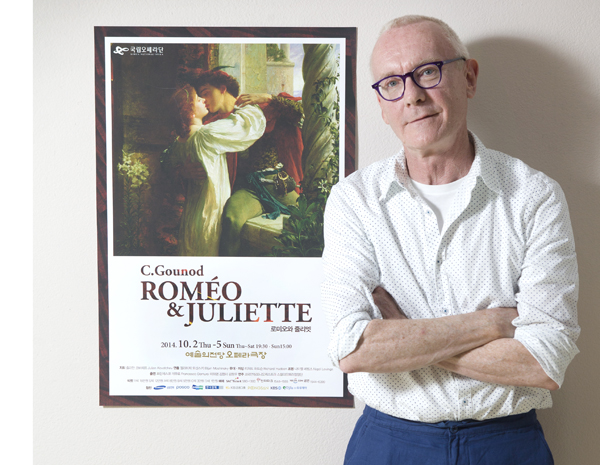For opera, a Shakespearean vision

Richard Hudson, a Zimbabwean stage and costume designer visited Korea to work on the upcoming opera, “Romeo and Juliette.” By Park Sang-moon
As the catalyst of the entire plot, it should be as dramatically portrayed on stage as it was in the animated film, when thousands of wildebeests rush straight for Simba as he cries for help. But how was it possible on stage?
That was the task the hit musical’s set designer, Richard Hudson, 60, had to figure out. And he did work it out - creating an illusion of thousands of racing animals using a canvas scroll and a series of large rollers. The musical won him the Tony Award for Best Scenic Design in 1998.
But although the Zimbabwean designer is best known for those achievements, his specialization is actually opera.
“It’s quite interesting the way my career has changed over the years,” Hudson said. “I started off as an assistant to a famous Greek designer who lived in London. He worked mainly in ballet, designing for great dancers and choreographers like the Russian dancer Rudolf Nureyev and the British choreographer Kenneth MacMillan. Working with him, I learned a lot about the ballet and loved that whole world. But my own career started to take off, and somehow I got into opera. Since then, I’ve been designing operas now for 30 years.”
Hudson said it was only within about the last five years that directors began to ask him to design for classical ballet productions.
He is currently working on “Sleeping Beauty” for the American Ballet Theater.
“I jump from one thing to another,” he said. “That’s what I love about this job. The scale of my job can be so different. Sometimes, I can do a play with just two people. The smallest job I ever worked was a one-woman show, while the biggest job I ever did was an opera in Paris, which required 700 costumes.”
Hudson recently visited Korea for the first time to work on stage and design the costumes for the upcoming “Romeo and Juliette” by the Korea National Opera. The show, to be staged four times, is scheduled to kick off in October at the Seoul Arts Center in southern Seoul.
Hudson said he previously designed a ballet of the “Romeo and Juliet” three years ago, though it’s his first doing the opera, which will be a completely new production.
“Emphasis in this production is on the period,” he said. “The period that Shakespeare wrote the play ... I wanted it to have the kind of Italian Renaissance feel to it, but also to look quite modern.”
For the color scheme, Hudson said he selected “quite a unique color” - the hue he saw at the Chapel of Scrovegni in Padua in northern Italy.
“The ceiling of the chapel is a dome and it contains a fresco cycle by Giotto,” he said. “The ceiling is painted in this amazing blue with gold stars. That’s, in fact, where I got the idea to start off the designs for this production.”
Although Hudson studied at the Wimbledon School of Art, he never saw an opera or a ballet until he came to England at the age of 18.
The set designer was brought up on a remote farm in Africa, where he often spent time alone. It was his godfather, a carpenter who once built the young Hudson a puppet theater, who sparked his passion for theater and design.
“When I was a child, I loved playing with [the puppets] and making the costumes, painting the scenery behind the puppets and all that,” he said. “I came to England when I was 18 and until then, I had never seen a professional theater, let alone an opera or ballet.”
It’s hard to imagine the scale of work a stage and costume designer is required to take on. Hudson says it’s as detailed as worrying over whether hooks or bars would better allow singers to change costumes more quickly. And it’s as broad as critiquing smooth scene changes as well as a production’s entire environment.
The whole process, however, requires collaboration, Hudson said, and working closely with others.
“That’s the most important thing about my job. It’s about collaboration,” he added.
“First I collaborate with the director or the choreographer. Then I collaborate with all these other people, the set builders, actors or dancers, production managers, costume makers, costume supervisors, props makers, the scene painters. It’s all about collaboration and working together.”
Because it’s “all about collaboration,” Hudson believes the best outcome is when the work is a true result of working together. “In my opinion, when I look at the finished work on stage just before opening night, the best production is when I can’t remember who thought of what,” he said. “Everything just comes together. That’s when it’s really good. It doesn’t happen every time, but it’s very nice when it does.”
Although Shakespeare’s “Romeo and Juliet” has now been adapted as a play, an opera and a ballet, many Koreans may instinctively think of Baz Luhrmann’s “Romeo + Juliet,” with Leonardo DiCaprio. Though Hudson says it’s nothing like the 1996 film.
“The opera will be the opposite,” he said. “I mean, I thought the film was wonderful but it was very contemporary, grungy and rough. But this opera will be very beautiful, not only beautiful to look at but also beautiful to listen to because the music is really exquisite.”
BY yim seung-hye [sharon@joongang.co.kr]










with the Korea JoongAng Daily
To write comments, please log in to one of the accounts.
Standards Board Policy (0/250자)